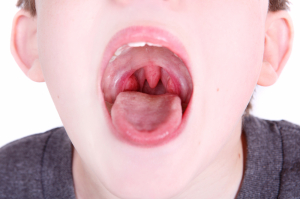Tonsillitis is an infection of the tonsils behind the back of the tongue on each side. The common name “tonsils” refers to the “palatine tonsils”, which are located on each side of the opening to the pharynx at the area of the back of the tongue.
Symptoms
When they get infected, which is a very common occurrence in children and adolescents, it hurts to swallow and the pain often gets referred to the ears. This is accompanied a high fever, vomiting, headaches and in children commonly a refusal to eat.
The tonsils can swell to a size two or three times the normal size with pus on the surface. Most of the time an acute tonsillitis is due to streptococcal disease, the most dangerous one of which is group A beta-hemolytic streptococcus. A culture of the surface of the tonsils will give the result of any bacterial growth in 1 to 2 days. In the case of a viral infection the culture will be reported as “normal flora”. Viral cultures are difficult to do as live cells or polymerization techniques need to be employed, which are technically difficult to do on a routine basis.
Different appearance between viral and bacterial tonsillitis
Here is an image that attempts to show the difference of appearance between a viral tonsillitis and a bacterial tonsillitis, although the truth is that nobody can really tell the difference, it is more about supporting the probability of the one or the other diagnosis. Because of the fear of missing a bacterial tonsillitis with the consequences mentioned below, viral tonsillitis has been over-treated (with inappropriate antibiotics). This has led to the emergence of super bugs that are resistant to antibiotics.
Alternative diagnoses
The doctor needs to think about alternatives of diagnoses such as diphtheria (due to Corynebacterium diphtheriae), infectious mononucleosis or trench mouth. With infectious mononucleosis the tonsils can be quite large and inflamed, but antibiotics do not change this condition, as it is due to a virus (the Epstein-Barr virus), which will not respond to them. The monospot test (a blood test) will detect antibodies against the virus 7 to 10 days into the disease. If the first test is negative, a repeat monospot test 1 week later would be reasonable.
Trench mouth
Trench mouth (or “Vincent’s infection “as it is also called) is a condition due to a spirochete bacillus, which can be identified by direct smears. This condition is characterized by punched out lesions on the gingiva around the gums and can spread to the tonsils. There is usually a very strong “bad breath” that accompanies trench mouth. Treatment for trench mouth is described here.
Tonsillitis
Treatment
Streptococcal tonsillitis is usually treated with penicillin. As some resistant bacteria have emerged that are resistant to penicillin, sometimes the physician has to , guided by culture and sensitivity reports, to switch the patient from penicillin V to amoxicillin.
However, many physicians still start treatment with penicillin V until the culture report is back. It is important to treat a Strep throat with a full course of antibiotics for 10 days as the toxins of group A streptococcus are thought to be responsible for the development of rheumatic fever (carditis and mitral valve disease) as well as Sydenham’s chorea, a seizure disorder. Patients who had rheumatic fever, have to follow a lifelong antibiotic prophylaxis with penicillin before a dental procedure and when a cold hits as they cannot afford a bacterial superinfection with a streptococcus strain again.
References
1. The Merck Manual, 7th edition, by M. H. Beers et al., Whitehouse Station, N.J., 1999. Chapter 161.
2. TC Dixon et al. N Engl J Med 1999 Sep 9;341(11):815-826.
3. F Charatan BMJ 2000 Oct 21;321(7267):980.
4. The Merck Manual, 7th edition, by M. H. Beers et al., Whitehouse Station, N.J., 1999. Chapter 43.
5. JR Zunt and CM Marra Neurol Clinics Vol.17, No.4,1999: 675-689.
6. The Merck Manual, 7th edition, by M. H. Beers et al., Whitehouse Station, N.J., 1999. Chapter 162.
7. LE Chapman : Antivir Ther 1999; 4(4): 211-19.
8. HW Cho: Vaccine 1999 Jun 4; 17(20-21): 2569-2575.
9. DO Freedman et al. Med Clinics N. Amer. Vol.83, No 4 (July 1999): 865-883.
10. SP Fisher-Hoch et al. J Virol 2000 Aug; 74(15): 6777-6783.
11. Mandell: Principles and Practice of Infectious Diseases, 5th ed., © 2000 Churchill Livingstone, Inc.
12. Goldman: Cecil Textbook of Medicine, 21st ed., Copyright © 2000 W. B. Saunders Company
13. PE Sax: Infect DisClinics of N America Vol.15, No 2 (June 2001): 433-455.
14. Suzanne Somers: “Breakthrough” Eight Steps to Wellness– Life-altering Secrets from Today’s Cutting-edge Doctors”, Crown Publishers, 2008







